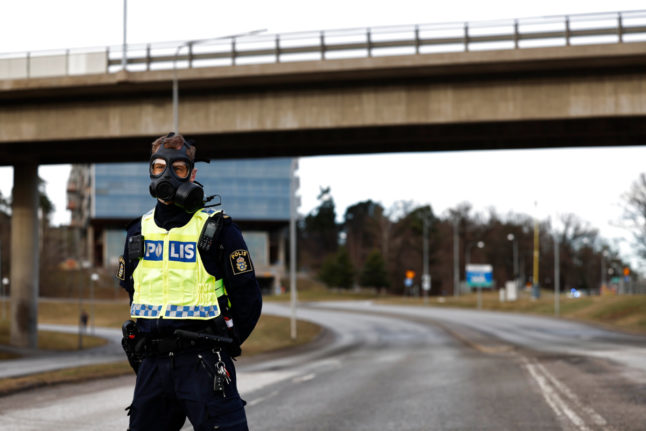What happened?
Police and emergency services were called to the headquarters of the Swedish security service, Säpo, in Solna, north of Stockholm, at around noon on Friday, after people in the building had reacted to “some kind of smell”, the Expressen newspaper reported at the time.
A few hundred people evacuated the building as chemical experts in gas masks investigated.
Around four hours later the cordons were lifted.
Eight people, including police officers investigating the scene, were taken to hospital with breathing difficulties. Two of them remained in hospital overnight for observation, but by Saturday everyone had been discharged, according to reports in the Swedish media.
What caused the incident?
Unconfirmed reports claimed early on that sensors on the roof of Säpo’s building had detected phosgene gas.
On Wednesday, Swedish newspaper Svenska Dagbladet (SvD) was able to access official documents from a meeting of the county administrative board held on Friday afternoon, which appeared to confirm that the sensors had indeed detected traces of phosgene.
“The emergency services have measured the substance phosgene (0.6 ppm) and during the meeting information emerged that the measured values are decreasing,” the document reads, as quoted by SvD.
It is however not known where the gas came from, or even if the sensors were faulty.
What is phosgene?
Phosgene is a colourless gas and a highly toxic pulmonary irritant.
It was used as a chemical warfare agent in the First World War where it was responsible for tens of thousands of deaths.
Today, it is used in industry, for example in production of PVC plastic, but it is strictly regulated and not available to ordinary consumers.
It can also be unintentionally produced through other processes, like welding. When the vapours of chlorinated solvents – chemicals used in industrial processes such as paint stripping or metal cleaning – are exposed to high temperatures, they can in some cases produce phosgene.
What’s Säpo saying?
Säpo has not confirmed the reports.
“We’re not going to say anything other than what we said on Friday, which is that the emergency services’ operation was concluded after they found that there was no gas neither inside nor outside the building,” press secretary Gabriel Wernstedt told news agency TT.
He could not say why the information he quoted from the emergency services differed from the information quoted in the report from the county administrative board’s meeting.
What are the experts saying?
Intelligence expert Joakim von Braun told TT that he doubted that anyone had intentionally released the gas.
“I have a very hard time seeing that, even though I’m good at finding conspiracies,” he said.
“It’s several hundred years old and was mainly used during the First World War. The research into chemical weapons is with FOI [the Swedish Defence Research Agency] up in Umeå, so I find it very hard to find a reasonable explanation as to why Säpo has a phosgene alarm. It sounds bizarre.”
He said he believed that if there were indeed traces of phosgene, they were probably there for another reason. “From welding, or something else, with carbon monoxide and chlorine gas then combining into either phosgene or something similar,” he said.



 Please whitelist us to continue reading.
Please whitelist us to continue reading.
Member comments